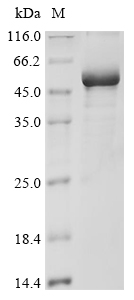Recombinant Human DNA damage-binding protein 2 (DDB2)
CAT:
399-CSB-EP846067HU-03
Size:
1 mg
Price:
Ask
- Availability: 24/48H Stock Items & 2 to 6 Weeks non Stock Items.
- Dry Ice Shipment: No




Recombinant Human DNA damage-binding protein 2 (DDB2)
- CAS Number: 9000-83-3
- Gene Name: DDB2
- UniProt: Q92466
- Expression Region: 1-427aa
- Organism: Homo sapiens
- Target Sequence: MAPKKRPETQKTSEIVLRPRNKRSRSPLELEPEAKKLCAKGSGPSRRCDSDCLWVGLAGPQILPPCRSIVRTLHQHKLGRASWPSVQQGLQQSFLHTLDSYRILQKAAPFDRRATSLAWHPTHPSTVAVGSKGGDIMLWNFGIKDKPTFIKGIGAGGSITGLKFNPLNTNQFYASSMEGTTRLQDFKGNILRVFASSDTINIWFCSLDVSASSRMVVTGDNVGNVILLNMDGKELWNLRMHKKKVTHVALNPCCDWFLATASVDQTVKIWDLRQVRGKASFLYSLPHRHPVNAACFSPDGARLLTTDQKSEIRVYSASQWDCPLGLIPHPHRHFQHLTPIKAAWHPRYNLIVVGRYPDPNFKSCTPYELRTIDVFDGNSGKMMCQLYDPESSGISSLNEFNPMGDTLASAMGYHILIWSQEEARTRK
- Tag: N-terminal 6xHis-tagged
- Source: E.coli
- Field of Research: Epigenetics and Nuclear Signaling
- Assay Type: Developed Protein
- Relevance: Protein, which is both involved in DNA repair and protein ubiquitination, as part of the UV-DDB complex and DCX (DDB1-CUL4-X-box) complexes, respectively. Core component of the UV-DDB complex (UV-damaged DNA-binding protein complex), a complex that recognizes UV-induced DNA damage and recruit proteins of the nucleotide excision repair pathway (the NER pathway) to initiate DNA repair. The UV-DDB complex preferentially binds to cyclobutane pyrimidine dimers (CPD), 6-4 photoproducts (6-4 PP), apurinic sites and short mismatches. Also functions as the substrate recognition module for the DCX (DDB2-CUL4-X-box) E3 ubiquitin-protein ligase complex DDB2-CUL4-ROC1 (also known as CUL4-DDB-ROC1 and CUL4-DDB-RBX1). The DDB2-CUL4-ROC1 complex may ubiquitinate histone H2A, histone H3 and histone H4 at sites of UV-induced DNA damage. The ubiquitination of histones may facilitate their removal from the nucleosome and promote subsequent DNA repair. The DDB2-CUL4-ROC1 complex also ubiquitinates XPC, which may enhance DNA-binding by XPC and promote NER. The DDB2-CUL4-ROC1 complex also ubiquitinates KAT7/HBO1 in response to DNA damage, leading to its degradation: recognizes KAT7/HBO1 following phosphorylation by ATR.; [Isoform D1]: Inhibits UV-damaged DNA repair.; [Isoform D2]: Inhibits UV-damaged DNA repair.
- Purity: Greater than 85% as determined by SDS-PAGE.
- Activity: Not Test
- Length: Full Length
- Form: Liquid or Lyophilized powder
- Buffer: If the delivery form is liquid, the default storage buffer is Tris/PBS-based buffer, 5%-50% glycerol. If the delivery form is lyophilized powder, the buffer before lyophilization is Tris/PBS-based buffer, 6% Trehalose, pH 8.0.
- Reconstitution: We recommend that this vial be briefly centrifuged prior to opening to bring the contents to the bottom. Please reconstitute protein in deionized sterile water to a concentration of 0.1-1.0 mg/mL.We recommend to add 5-50% of glycerol (final concentration) and aliquot for long-term storage at -20℃/-80℃. Our default final concentration of glycerol is 50%. Customers could use it as reference.
- Molecular Weight: 53.8 kDa
- References & Citations: "Human DDB2 splicing variants are dominant negative inhibitors of UV-damaged DNA repair." Inoki T., Yamagami S., Inoki Y., Tsuru T., Hamamoto T., Kagawa Y., Mori T., Endo H. Biochem. Biophys. Res. Commun. 314:1036-1043 (2004)
- Storage Conditions: The shelf life is related to many factors, storage state, buffer ingredients, storage temperature and the stability of the protein itself. Generally, the shelf life of liquid form is 6 months at -20℃/-80℃. The shelf life of lyophilized form is 12 months at -20℃/-80℃.
